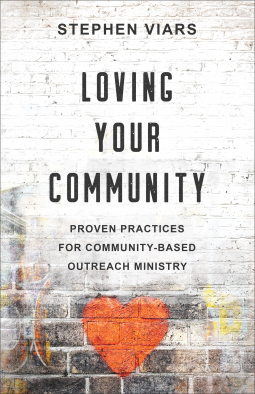Loving Your Community: Proven-Practices for Community-Based Outreach Ministry is a guide for how congregations can better reach out to their cities and neighborhoods. The first section offers a Biblical foundation with three chapters focused on (1) Loving, (2) Your particular, (3) community. The second section, which is the bulk of the book offers examples from the author’s own congregation of ways to meet a community’s real needs. Some fundamental ideas are to consider what assets your congregation has (property, skills, etc.) and focus on the needs of your community and not exclusively of your members. In discussing opening your facilities to the community, Viars summarizes the point of the chapter as to “find ways to get people into your building and then love them in the name of Christ”. The idea of making connections to love and serve people in the Christ’s name is the general idea of the whole book. The closing section briefly answers doubts and suggests ways to begin putting the ideas into practice.
My own view of the role of the Church is that we are called to a more specific focus. I am not convinced that the Church, as the Church and not as individual Christians, should be involved in doing good works simply because there is a need. In other words, I think we as individual Christians should do things in loving our neighbor that isn’t necessarily the calling of the Church as an institution. So my first criticism of the book is that it didn’t seem to offer a strong Biblical rationale for Churches to engage in the types of work given in the examples. Nor was much attention was given to show how the outreach of photography classes, opening facilities to birthday parties and providing skate parks was intentionally used to share the Gospel with people. The impression I got was that the church does good things and hopes that maybe some of this leads to visits or conversations.
Second, almost all of the examples used were from the author’s own, obviously large, congregation. As a pastor of a church that wouldn’t have the resources to build community center, run a seminary, or refurbish real estate I would have appreciated examples more within the reach of the average congregation.
That said I, I did find myself with a notepad jotting down ideas that occurred to me as I was applying the principles to my own context. I think there are stronger books for considering outreach and studying the needs of your community, but this book might be a helpful one to read along with others to see ways this specific congregation put things into practice.
Disclosure: I received this book free from Baker Books through the Baker Books Bloggers www.bakerbooks.com/bakerbooksbloggers program. The opinions I have expressed are my own, and I was not required to write a positive review. I am disclosing this in accordance with the Federal Trade Commission’s 16 CFR, Part 255 http://www.access.gpo.gov/nara/cfr/waisidx_03/16cfr255_03.html.
